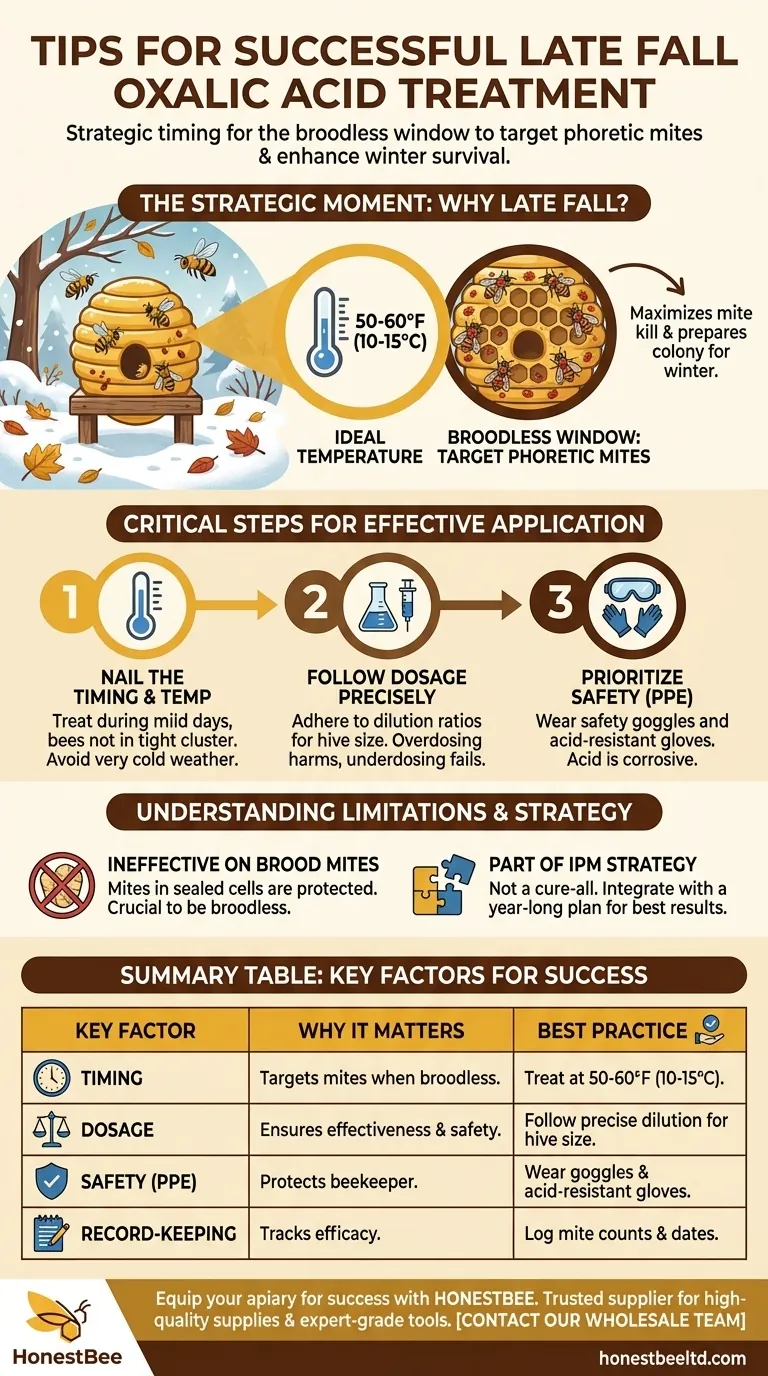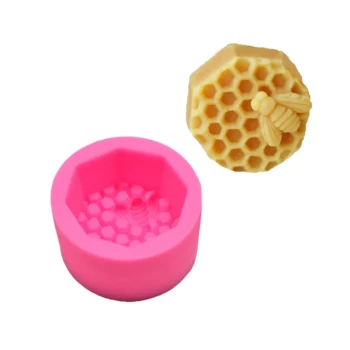Successful late fall oxalic acid treatment hinges on four key factors: timing the application for a broodless period when temperatures are mild, following precise dilution and dosage instructions for your hive size, wearing appropriate protective gear, and keeping detailed records to measure effectiveness. This approach maximizes mite kill while ensuring the safety of your colony heading into winter.
The core principle of a late fall oxalic acid treatment is to strike when the Varroa mite is most vulnerable. This occurs when the bee colony is broodless, exposing nearly the entire mite population on adult bees and making a single, well-timed treatment highly effective.

Why Late Fall is the Strategic Moment
Understanding the "why" behind the timing is crucial for success. The late fall application isn't arbitrary; it's a strategic intervention based on honeybee and Varroa mite biology.
Targeting Phoretic Mites
Oxalic acid treatment is a contact-based miticide. This means it only kills Varroa mites that are physically on the bodies of adult bees, known as phoretic mites.
The treatment cannot penetrate the wax cappings of brood cells. Therefore, any mites reproducing within sealed brood cells are completely protected from its effects.
The "Broodless" Window of Opportunity
In late fall, as temperatures drop, the queen bee naturally ceases or dramatically reduces her egg-laying. This results in a period where the colony has little to no sealed brood.
This broodless state is the ideal window for treatment. Nearly all the mites in the hive are in the phoretic stage on adult bees, making them vulnerable to the oxalic acid application.
Enhancing Winter Survival
A high mite load is a primary driver of winter colony losses. By significantly reducing the mite population just before winter, you relieve stress on the colony.
Healthier, mite-free bees are better able to form a tight winter cluster, regulate temperature, and conserve resources, dramatically increasing their chances of survival and emerging as a robust colony in the spring.
Critical Steps for Effective Application
Executing the treatment correctly is just as important as timing it right. Carelessness in application can reduce effectiveness or even harm your bees.
Nail the Timing and Temperature
Plan your treatment for a day when temperatures are between 50-60°F (10-15°C). This is warm enough that the bees are not in a tight, defensive cluster, allowing the treatment to be distributed more effectively.
Avoid treating in very cold weather, as breaking the cluster can cause unnecessary stress to the colony.
Follow Dosage and Dilution Precisely
Always adhere to the recommended dilution ratios and application dosages for the specific oxalic acid product you are using. Overdosing can harm or kill your bees, while underdosing will be ineffective against mites.
The correct dosage is typically based on the number of frames of bees in the hive. Measure carefully to ensure each colony receives the proper amount.
Prioritize Your Safety
Oxalic acid is a corrosive organic acid. Always wear the recommended personal protective equipment (PPE), including safety goggles and acid-resistant gloves, during mixing and application.
Understanding the Limitations
To be a truly effective beekeeper, you must understand the limitations of any tool you use. Oxalic acid is powerful, but it is not a cure-all.
Ineffective Against Mites in Brood
This cannot be overstated: if your colony still has a significant amount of sealed brood, the efficacy of the treatment will be drastically reduced. Many mites will remain safe under the cappings, ready to emerge and re-infest the colony.
It's a Tool, Not a Complete Strategy
A late fall oxalic acid treatment is one component of a comprehensive Integrated Pest Management (IPM) plan. It should not be the only mite control method you use throughout the year.
Relying solely on one treatment can lead to resistance and may not be sufficient to keep mite levels below damaging thresholds during other parts of the season.
How to Apply This to Your Goal
Your specific goal will determine how you integrate this information into your beekeeping practice.
- If your primary focus is maximum mite reduction: Confirm your colony is truly broodless before treating; this is the single most important factor for high efficacy.
- If your primary focus is colony health and survival: Use this treatment as the final step in a year-long mite management plan to send your bees into winter with the lowest possible mite load.
- If your primary focus is long-term improvement: Keep detailed records of pre-treatment mite counts, treatment dates, and post-treatment results to refine your strategy year after year.
Proactive and well-timed mite management is the foundation of successful and sustainable beekeeping.
Summary Table:
| Key Factor | Why It Matters | Best Practice |
|---|---|---|
| Timing | Targets mites when bees are broodless. | Treat when temps are 50-60°F (10-15°C). |
| Dosage | Ensures effectiveness and bee safety. | Follow precise dilution for hive size. |
| Safety (PPE) | Protects the beekeeper from acid. | Wear goggles and acid-resistant gloves. |
| Record-Keeping | Tracks effectiveness for future seasons. | Log mite counts and treatment dates. |
Equip your apiary for success with HONESTBEE. A single, well-timed oxalic acid treatment is a cornerstone of effective Varroa mite control, but it requires precision and the right equipment. As a trusted supplier for commercial apiaries and beekeeping equipment distributors, HONESTBEE provides the high-quality supplies and expert-grade tools you need to execute this critical treatment safely and effectively. Ensure your colonies enter winter strong and healthy—contact our wholesale team today to discuss your needs and optimize your Integrated Pest Management (IPM) strategy.
Visual Guide

Related Products
- Adjustable Formic and Acetic Acid Dispenser for Bee Mite Treatment
- Professional Bamboo Queen Isolation Cage
- Varroa Easy Check Mite Tester Kit Counter Alcohol Wash Jar
- Langstroth Screen Bottom Board for Beekeeping Wholesale
- Metal Queen Bee Excluder for Beekeeping
People Also Ask
- What is the optimal time for varroa mite control in nucs? Maximize Efficacy with Perfect Timing
- What are phoretic mites? A Beekeeper's Guide to Monitoring Varroa Infestation
- What does Chewed Down Brood (CDB) indicate in bee colonies? A Sign of Varroa Mite Infestation
- What are the symptoms of Varroa Mite Syndrome (VMS)? Recognizing the Signs of Colony Collapse
- What should be done after treating a colony for varroa mites? A Step-by-Step Guide to Verifying Success



















